
© 2010-2022 by Fine Arts of the Southwest, Inc. All rights reserved.
Unauthorized reproduction or use is strictly prohibited by law.
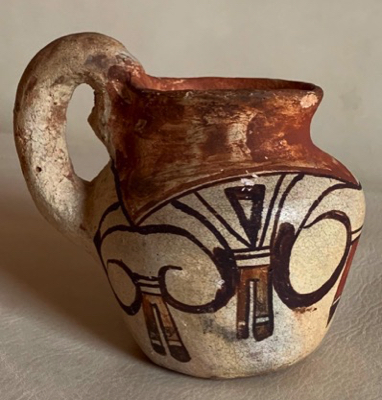
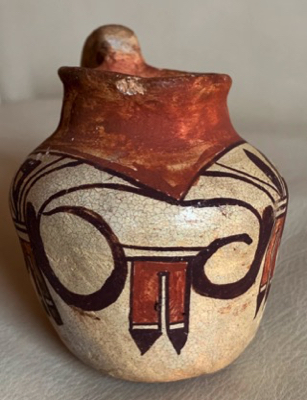
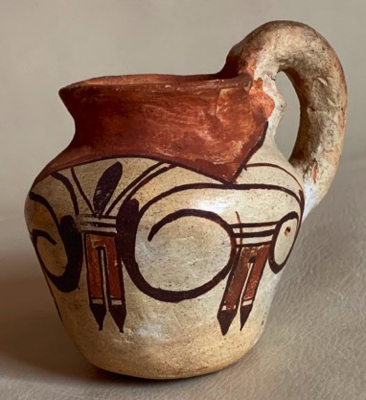
A lovely small Hopi Polacca polychrome pottery
pitcher most likely made by Annie Nampeyo, c.1895
This is a charming and wonderful piece of historic Hopi pottery and it immediately leads one to some fascinating speculation. First off, the formal ceramic type in evidence here is known as “Polacca Polychrome, Style D” which was made in the period around 1890-1900.* Because of its very finely crackled slipped surface this particular vessel dates from around the middle of this Polacca type period, approximately 1895. Second, are the particular design motifs on this vessel which at this time period are particular to the family of the renowned pottery Matriarch, Nampeyo of Hano.
Nampeyo’s so-called “eagletail” design displayed on this pitcher is an innovation she adapted from the ancient Sikyatki polychrome pottery vessels which were made in the area of the Hopi mesas from 1375-1625 A.D. In the ten years or so before this little vessel was made only Nampeyo and her noted pottery-maker mother, White Corn, were making vessels with this particular design scheme. In 1884, Nampeyo gave birth to her first child, Annie (1884-1968) who would have been about ten to twelve years of age when this little pitcher was made which is right about the time when young Pueblo girls usually begin making pottery at their Mother’s side.
Let us try to imagine the historic scene taking place here in Hano village on the top of the Hopi First Mesa; at this point in time Hopi women spent their days hauling water, cooking food, raising children and in the cases of certain families, making pottery. Nampeyo was born into a family of noted potters and accordingly she became a potter herself of remarkable skill and ability. Naturally, when she had daughters of her own, she raised them to become potters in the family tradition using what were then becoming to be known as Nampeyo family designs which they viewed in a somewhat proprietary fashion.
So on a hot summer day in say July of 1894; Nampeyo is seated on a blanket making pottery in front of her stone house. She is in the final stages of forming a vessel from the pile of raw clay nearby. Before her, sits a stone metate on which some black and red paints have been prepared from hand ground local plants and minerals. Seated next to Nampeyo is the young 10-year old Annie who is trying to imitate her Mother’s work with the clay. Her young fingers are not yet as nimble as they would soon become, but under her Mother’s watchful eye and with some direct assistance she forms the walls of this little pitcher in the “pinch-pot” style beginning potters often use meaning that the clay body is formed from pinched together small pieces of clay rather than formed from more difficult to make coils of clay. Nampeyo then helps Annie smooth the formed vessel walls with a stone and the pitcher is left to dry. Later that day or the next it is time to apply the slip over the raw clay body and after it has dried to then paint the design on the pitcher.
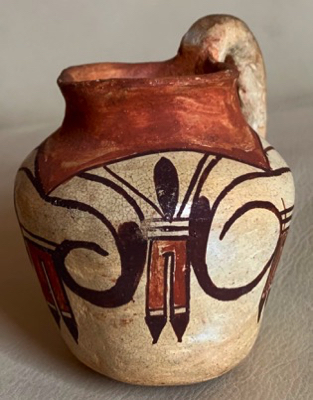
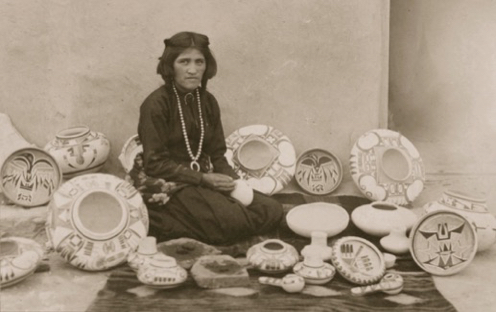
Annie Nampeyo with a selection of pottery made by her and Nampeyo, c. 1910
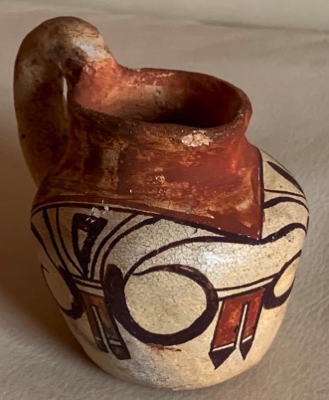
Nampeyo shows little Annie how to chew the Yucca plant stem to fashion a brush and with her helping hand Annie begins to paint the vessel using a design she has seen her Mother make numerous times before and with her Mother’s helping hand and experience to guide her she paints the vessel with the characteristic Nampeyo symmetrically oriented “eagletail” motif with a red painted square on top from which the eagle tail and feather designs descend. When the paint is dry and the vessel is ready to fire, Nampeyo builds the fire and places this vessel along with a number of others of her own manufacture in the kiln and fires the pottery.
A day or so later, Nampeyo and Annie are again sitting outside their home making pottery while an assortment of finished pottery vessels including this little pitcher are set up for display and possible purchase alongside them as pictured above. At this point in time, Nampeyo is rapidly becoming somewhat of a Southwestern art celebrity and is visited regularly by a steady stream of anthropologists, archaeologists, Indian traders, Western artists, photographers and other prominent travelers on the Santa Fe Railway many of whom are anxious to purchase pieces of her pottery. And perhaps, on this particular day, along with a piece of Nampeyo’s pottery someone is purchasing, they notice this charming little pottery vessel by the young Annie and they ask to purchase it too. In this way does this diminutive vessel leave the Hopi mesas on the journey by which it would eventually, a century and a quarter later, come to us.
Now, of course, we are not saying that this is precisely what happened here, but this is an entirely plausible and very possible scenario to picture. We know that this piece is a Nampeyo family piece and we know when it was made and thus by the process of elimination, we have a fairly good idea that the young Annie Nampeyo made it. If the vessel had been made ten years later there would have been a second Nampeyo daughter, Nellie, born in 1896, who might also have been a candidate but this piece was not made in 1904. The technique here needs some refinement perhaps, but the talent of the young potter is already abundantly clear.
The pitcher measures approximately 3 1/4” in height and is around 3 1/4” in diameter. It is in excellent original condition particularly so in light of its 125 or so years of age. There are a couple of chips, small scuffs and surface abrasions.
All in all, this is a delightful small piece of historic Hopi pottery. It is also an especially unique window into the career
a young and talented artist born into a great family and cultural tradition who would over the years uphold that tradition proudly and beautifully, creating many distinguished artworks over the course of her long life.
Price $750
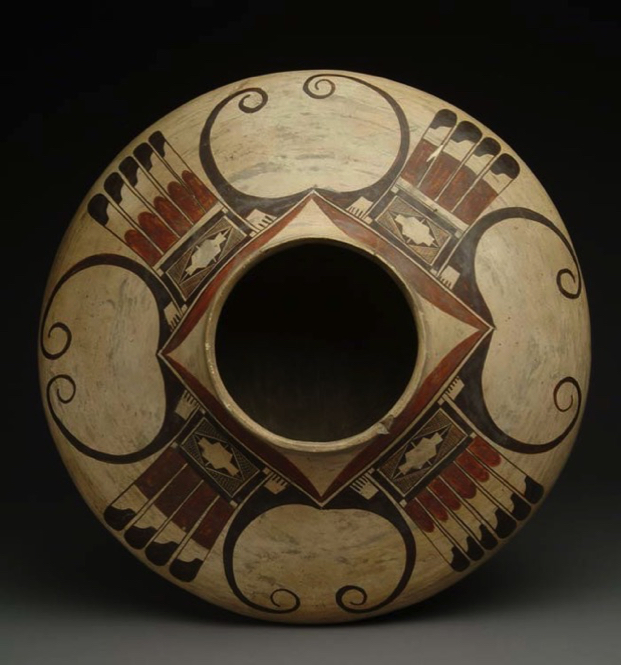
A large Nampeyo pottery jar painted with her famous “eagletail” design. 16” in diameter. We sold this
jar to the Art Institute of Chicago in 2003 and it is on display there as part of their permanent collection.
Photo: Addison Doty, Santa Fe
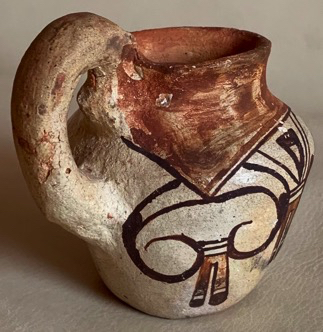
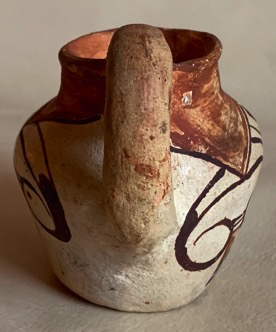
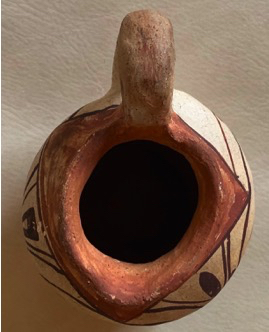
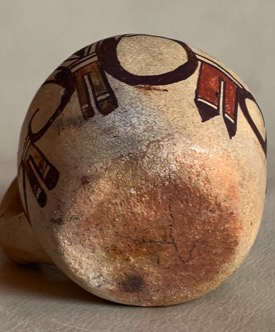
* Historic Hopi Ceramics, The Thomas V. Keam Collection of the Peabody Museum of Archaeology and Ethnology, Harvard University. Edwin L. Wade and Lea S. McChesney, Peabody Museum Press, 1981.